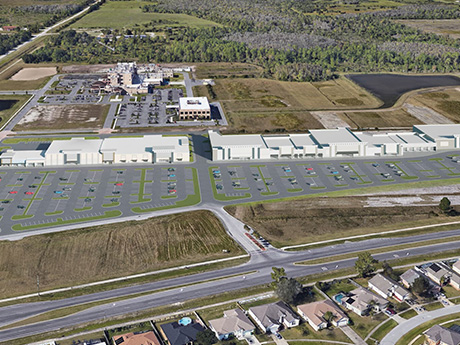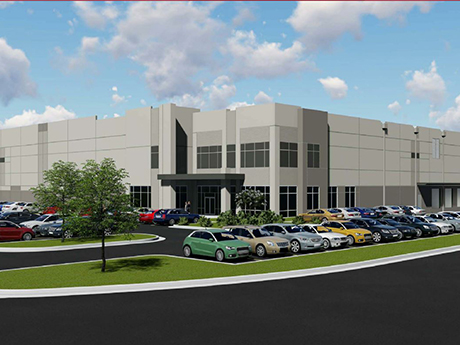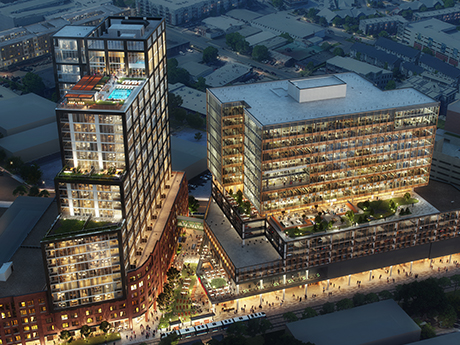Orlando’s industrial market continues to maintain strong market fundamentals. Despite leasing activity temporarily softening at the midway point of 2023 compared to the end of second-quarter 2022, exceptionally low vacancy rates persist, putting upward pressure on asking rental rates and further strengthening developer confidence in the market. With its strategic locational advantages and diverse tenant mix, the sector is well-positioned for future growth. According to Florida Commerce, Orlando’s unemployment rate is 2.6 percent, well below the national rate of 3.6 percent. Labor shortages remain, as jobs increased by 5,300 in the industrial-using sector and 6,200 in trade, transportation, and utilities. At the same time, Central Florida’s population growth — along with the state’s business-friendly conditions, from no state income tax to relative affordability — consistently spurs demand for e-commerce logistics and warehousing throughout the region. Asking rates surge Year-to-date industrial leasing volume in Orlando has been 4.4 million square feet, 2.4 million square feet of which was in the second quarter. Total vacancy stood at 3.5 percent in the second quarter, significantly lower than the national vacancy rate of 5.4 percent. The average asking rate for industrial properties in Orlando was $10.77 triple-net per square foot, reflecting a 5.4 percent …
Southeast Market Reports
The demand for retail space throughout Central Florida has been extremely high as new concepts are moving into the marketplace due to the mass exoduses from New York City and California. With the major population shift, we are running into the issue of limited supply to lease. Vacancy rates are currently projected at 3.8 percent, which is approximately 100 basis points below the 10-year historical average. Vacancy rates are projected to meet the mid-4 percent range by the end of 2023 due to the expected completion of more than 700,000 square feet of retail space during the fourth quarter, according to research from CoStar Group. Some developers are backing out of ground-up development deals due to the heightened labor and construction costs that every firm is experiencing. However, there are still some notable developments occurring in certain trade areas such as Minneola, Lake Nona, Apopka (Kelly Park) and Davenport, which are just some of the areas with projects expected to deliver in the fourth quarter of this year. These new ground-up projects require lessees to pay a higher rent to make these deals pencil out. The current average asking rate in Orlando is $27.77 per square foot, well ahead of …
The Orlando office market saw improved office activity in the second quarter after a somewhat slow start to the year. Quarter-over-quarter, the average deal size rose by 11.2 percent with Downtown, South Orlando and East Orlando as the three submarkets benefitting from an increase in office leasing activity. The majority of institutional landlords in downtown Orlando are some of the early adopters of flight-to-quality phenomenon, and as a result, tenants from other submarkets have shifted their focus to the city’s Central Business District (CBD). On the other hand, South Orlando enjoys a built-in advantage of having perhaps the greatest number of restaurant options in the greater Orlando area, with easy access to both Sand Lake Road and Millenia Mall areas offering various food options. The need to be co-located with some of the military branches located in Central Florida Research Park drives many simulation and military/defense sector tenants to seek office space in East Orlando, also providing nearby access to the University of Central Florida. Aside from geographical location, more and more tenants are seeking out higher-quality office space while rightsizing their footprint. This is predominantly fueled by flex/remote office schedules combined with the need for employers to provide an …
Orlando remains one of the strongest multifamily markets nationally despite the slowdown being experienced in commercial real estate at large. Its strength is largely defined by growth in rent, supply, upcoming development opportunities, employment and the local economy, which have all contributed to healthy fundamentals. Being a top U.S. tourism destination has also helped with more than 74 million visitors coming to Orlando in 2022. Local tourism has created 212,000 jobs as of year-end 2021, and the city is home to nine world-renowned theme parks that are frequented by tourists. Orlando has also proven to be a very attractive and viable place to live long-term. The city is the fourth-largest in Florida, with an estimated population of more than 312,200 in 2023 and over 2 million within the metropolitan statistical area (MSA). The area’s population growth has supported multifamily growth opportunities, ensuring there is a vast renter pool and demand for the inventory that continues to be delivered. That has propelled rent growth up with submarkets like Colonial Town and Florida Center North, which are still posting year-over-year increases between 10 and 16 percent, significantly higher than the national average. Overall supply has also held up well with 6,103 units …
In January of 2023, the Memphis industrial market was coming off multiple years of record-breaking growth. However, mid-year we seem to be trending back to a somewhat normal growth pattern. The Memphis industrial market, which was fueled by the pandemic like many other markets, is finally beginning to normalize. Economic factors also influence the market as well. First and foremost is the uncertainty: uncertainty in interest rates, uncertainty in construction costs and uncertainty in when will we see some signs of stabilization. Many say we need to survive until 2025. Yet, the Memphis industrial market seems to have all the tools to handle this moment, and move forward. Memphis, located on the borders of Tennessee, Arkansas and Mississippi, is known as “America’s Distribution Center” — boasting unparalleled expertise in distribution and logistics. With a central location, Memphis’ transportation infrastructure comprises the four Rs: runway, rail, river and road. Memphis International Airport houses the largest cargo airport in the world with the FedEx worldwide hub. Memphis is one of only three cities in the country that has five of the seven Class I railroads: Union Pacific/Southern Pacific, Burlington Northern Santa Fe (BNSF), CSX Corporation, Norfolk Southern and Canadian National Railroad (CN). …
The Memphis office market posted 271,828 square feet of positive absorption in 2022, and that momentum has carried into the first half of 2023. Like most markets, Class A properties accounted for the majority of positive absorption, at 218,851 square feet. This trend has already carried into 2023, as Class A properties lead net absorption totals to begin the year. As a result of a strong year, the vacancy rate has fallen to 12.4 percent market-wide, an 840-basis-point decrease from the height of the pandemic. Additionally, sublease availabilities are less prevalent in Memphis than other comparable office markets. Currently there is 257,681 square feet of sublease space available in the Memphis market, which has a total net rentable area of 21.7 million square feet. The average among similarly sized Southeast markets is 422,624 square feet. There haven’t been substantial space additions to outweigh the below-average leasing activity thus far in 2023. The Memphis unemployment rate continues to trend downward to 3.2 percent in April, slightly lower than Tennessee’s 3.3 percent unemployment rate and the national rate of 3.7 percent. The tight labor market has increased demand in East Memphis, as tenants demand high-quality, highly amenitized buildings to attract and retain …
It’s no secret: The multifamily real estate market in Memphis has experienced a significant decline in investment sales volume and total transactions over the past year. But with signs of life coming quickly on the horizon, how can you be ready to capitalize? According to CoStar Analytics, the 58.7 percent sales volume decline in Memphis is in line with the national average, but we have seen a larger dip in total transactions. The steep and rapid decline is directly correlated to the Federal Reserve’s ongoing battle of taming inflation. The Fed has increased the benchmark federal funds rate at 10 consecutive meetings. And while there was a pause at the June meeting, more rate hikes are expected this year. What does this mean for investors and operators? The cream will rise to the top. Some investors may default on loans due to floating-rate debt and the rapid rate increases, while others may struggle to refinance or sell without incurring losses as their cheaper rate caps expire. However, those that have executed their business plans effectively and added value to their apartment complexes by raising rents can expect some cushion. Another interesting factor to examine is the vacancy rate, which has …
The term “grit” has become synonymous with Memphis. The commercial real estate landscape continues to receive headwinds from interest rates, high inflation, construction prices and geopolitical tensions, but Memphis continues to show grit in the face of these obstacles. Memphis presents a compelling opportunity for retailers seeking expansion. With a low vacancy rate of just 3.5 percent and strong occupancy levels, the city’s retail market is flourishing. The annual rent growth of 3.7 percent aligns with the national average, indicating a stable and promising environment for businesses. Moreover, Memphis offers competitive pricing for retail spaces, with affordable rates and attractive cap rates that surpass those of neighboring markets. This appealing pricing structure, coupled with a surge in transaction activity, has revitalized the market, providing increased liquidity and investment opportunities. The Regional Megasite of West Tennessee is witnessing a remarkable undertaking from Ford Motor Co. in its newly forged partnership with South Korean battery company SK Innovation. The ambitious Blue Oval City project is well underway. Currently valued at $5.6 billion and sprawling across 3,600 acres, the project is expected to generate nearly 6,000 job opportunities with another 30,000 ancillary jobs in the surrounding communities. Anticipated spillover effects from this venture …
Central Florida retail is alive, well and growing, thanks in large part to Florida’s continuing resilience to the nation’s economic challenges. Thousands of people are moving to the state each week, the Orlando area’s economy continues to diversify beyond tourism and residents continue to show confidence with their retail spending. That said, there are significant challenges facing new retail developments, due to the cost of construction and other inflationary pressures. We expect this to be a major issue for the rest of this year, and it will require thoughtful planning for everyone involved in these projects. As we look at the remainder of 2023, we see two big takeaways: • For brick-and-mortar retail, it’s important for developers and owners to bring in concepts that are new and fresh. In some cases, this involves established retailers getting creative with their spaces, like what Macy’s is doing with its new Market by Macy’s concept, which uses a smaller footprint than traditional Macy’s stores. • To make new retail developments happen, developers, landlords and tenants need to be inventive in how they structure deals, whether it’s sharing in construction cost overages or giving tenants more time to get their spaces ready. With that …
In the wake of the COVID-19 pandemic, Charlotte’s retail segment has experienced a remarkable revitalization, fueled by a convergence of factors that have reinvigorated the city’s economic landscape. With a thriving job market, affordable cost of living and a surge in adaptive reuse, mixed-use and infill projects, Charlotte has become a hotbed for retail activity. As the city emerges from the challenges of the pandemic, it has embraced innovative approaches to urban development, transforming once-vacant spaces into vibrant hubs of commerce. Several macro-economic trends have impacted retail growth in Charlotte. Population growth in the city has spurred an increase in consumer demand, leading to a vibrant retail market. In a May 18 article from the Charlotte Business Journal, it was noted Charlotte added more than 15,000 people to its population count between 2021 and 2022, the nation’s fifth-highest numeric increase during that span, according to the latest estimates from the U.S. Census Bureau. As more people choose to settle in Charlotte, the demand for goods and services has risen, prompting retailers and restaurants to expand their operations and invest in new locations. Additionally, the rise of e-commerce and the shift toward online shopping have compelled retailers in Charlotte to adapt …











